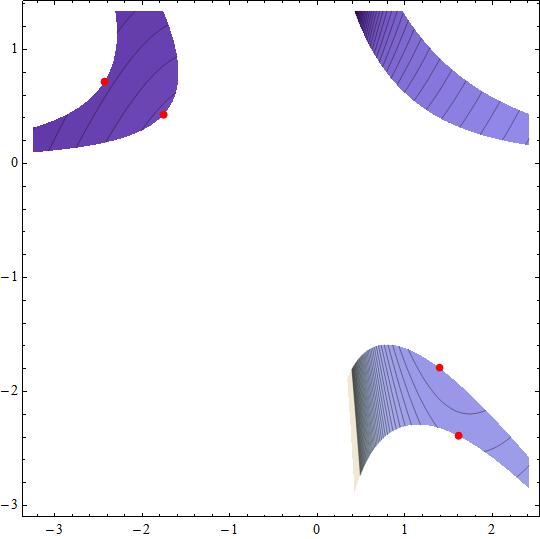With the so called slack variables #s_1, s_2# we transform the maximization/minimization with inequality constraints problem, into a formulation amenable for the Lagrange Multipliers technique.
Now the lagrangian formulation reads:
minimize/maximize
#f(x,y) = f(x,y)=2x-y+(x-2y)/x^2#
subjected to
#g_1(x,y,s_1) = x y^2+x^2y -s_1^2 -1=0#
#g_2(x,y,s_2) = x y^2+x^2y +s_1^2 -3=0#
forming the lagrangian
# L(x,y,s_1,s_2,lambda_1,lambda_2) = f(x,y)+lambda_1g_1(x,y,s_1)+lambda_2 g_2(x,y,s_2)#
The local minima/maxima points are included into the lagrangian stationary points found by solving
#grad L(x,y,s_1,s_2,lambda_1,lambda_2) = vec 0#
or
#{
( (4 y + x^3 (2 + (lambda_1 + lambda_2) y (2 x + y)))/x^3 - 1/x^2=0),
((lambda_1 + lambda_2) x (x + 2 y) - 1 - 2/x^2=0),
(1 + s_1^2 - x y (x + y)=0),
(lambda_1 s_1 = 0),
(s_2^2 + x y (x + y) -3=0),
(lambda_2 s_2 = 0)
:}#
Solving for #x,y,s_1,s_2,lambda_1,lambda_2# we obtain
#(
(x = -2.43526, y= 0.716915, l1 = 0, s1= -1.41421,
l2= 0.548335, s2 = 0),
(x = -2.43526, y = 0.716915, l1= 0, s1 = 1.41421,
l2 = 0.548335, s2= 0),
(x= 1.60753, y= -2.38878, l1 = 0, s1 = -1.41421,
l2= -0.348111, s2 = 0),
(x = 1.60753, y = -2.38878, l1 = 0, s1 = 1.41421,
l2= -0.348111, s2 = 0),
(x = -1.75902, y = 0.426693, l1 = 1.03348, s1 = 0, l2= 0,
s2= -1.41421),
(x = -1.75902, y = 0.426693, l1 = 1.03348, s1 = 0, l2 = 0,
s2 = 1.41421),
(x = 1.39063, y = -1.79193, l1 = -0.666958, s1 = 0, l2 = 0,
s2 = -1.41421),
(x = 1.39063, y = -1.79193, l1 = -0.666958, s1= 0, l2 = 0,
s2 = 1.41421)
)#
Those eight points are truly four. The first and second activate constraint #g_2(x,y,0)# and the two other activate constraint #g_1(x,y,0)# and their qualification will be done with
#f@g_1 (x) = 2/x + (5 x)/2 + sqrt[4 + x^3]/x^(5/2) + sqrt[4 + x^3]/(2 sqrt[x])# and
#f@g_2(x) =2/x + (5 x)/2 + sqrt[12 + x^3]/x^(5/2) + sqrt[12 + x^3]/(2 sqrt[x])#
giving
#d^2/(dx^2)f@g_1 (-1.75902) = -8.29064# local maximum
#d^2/(dx^2)f@g_1 (1.39063) = 5.90567# local minimum
#d^2/(dx^2)f@g_2 (-2.43526) = -8.85699# local maximum
#d^2/(dx^2)f@g_2 ( 1.60753) = 5.10192# local minimum
Attached a figure with the #f(x,y)# contour map inside the feasible region, with the local maxima/minima points.



